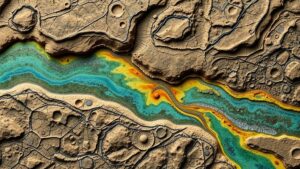How Old Roadway Expansion Plans Reveal Buried Historical Sites
How Old Roadway Expansion Plans Reveal Buried Historical Sites
The exploration of historical sites through roadway expansions has brought significant insights into our understanding of past civilizations. In many cases, these expansions have inadvertently led to the discovery of ancient artifacts and structures, offering a glimpse into the historical narratives that shape our present. This article delves into how old roadway expansion plans reveal buried historical sites, providing a comprehensive analysis supported by concrete examples and relevant data.
Historical Context of Roadway Expansions
Throughout the 20th century, many urban areas engaged in extensive roadway expansion to accommodate growing populations and increasing traffic demands. According to the Federal Highway Administration, the National Highway System underwent massive upgrades in the 1950s and 1960s, which often involved disrupting previously untouched land. Historical records reveal that this led to unintentional archaeological excavations when construction crews encountered artifacts or remnants of past civilizations.
Notable Discoveries in Expansion Projects
Various cities have experienced significant discoveries as a direct result of roadway expansion plans. For example, in 2012, highway construction projects in San Francisco unveiled remnants of a 19th-century ship, the S.S. City of Chester, buried beneath the streets. This shipwreck was an important part of maritime history and provided valuable insights into the shipping trade during the Gold Rush era.
Another prominent example occurred in Baltimore, Maryland. In preparation for the expansion of the Baltimore Inner Harbor, workers uncovered a collection of artifacts dating back to the 18th century, including pottery, tools, and personal items. e findings not only highlight everyday life during that period but also indicate the areas social and economic activities.
Technological Advances in Archaeological Methodologies
Modern archaeological methods have vastly improved the ability to uncover and analyze buried sites. Geophysical techniques, such as ground-penetrating radar (GPR) and conductivity surveying, are increasingly utilized in preliminary assessments before excavation. For example, GPR has been instrumental in locating subsurface anomalies that signify the presence of historical structures without extensive digging, thus minimizing the impact on the environment.
Critical Ethical Considerations
The intersection of infrastructure development and archaeological preservation raises important ethical questions. National Historic Preservation Act (NHPA) of 1966 mandates federal agencies to consider the effects of their projects on historical sites. This law encourages collaboration between construction companies and archaeologists, aiming to preserve and document sites that may otherwise be lost.
- Incorporating archaeological assessments during planning phases.
- Providing public access to findings for educational purposes.
In the case of Los Angeles, California, the United States Army Corps of Engineers implemented partnerships with local archaeologists during the planning of the Los Angeles River revitalization project to ensure that historical elements were preserved while still meeting urban development needs.
Real-World Applications of Discoveries
Discoveries made during roadway expansions are not merely academic; they have real-world implications for cities and communities. The knowledge gained from these sites enriches local heritage and can drive tourism revenue. For example, after artifacts were uncovered in Charleston, South Carolina, the local government promoted the site as a tourist attraction, showcasing the citys rich colonial history.
Actionable Takeaways
The lessons learned from roadway expansion plans provide valuable insights for future urban development. Key strategies moving forward include:
- Conducting thorough pre-construction archaeological assessments to identify potential sites.
- Engaging with local historians and archaeologists to create collaborative plans that respect historical integrity.
- Raising public awareness about the importance of preserving historical sites during infrastructure projects.
As urban landscapes continue to evolve, understanding and preserving our historical sites play a crucial role in honoring our collective past. Through thoughtful planning and strategic collaboration, we can ensure that roadway expansions serve not only as pathways for vehicular traffic but also as conduits to our shared history.


